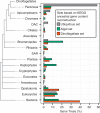Horizontal gene transfer is a significant driver of gene innovation in dinoflagellates
- PMID: 24259313
- PMCID: PMC3879968
- DOI: 10.1093/gbe/evt179
Horizontal gene transfer is a significant driver of gene innovation in dinoflagellates
Abstract
The dinoflagellates are an evolutionarily and ecologically important group of microbial eukaryotes. Previous work suggests that horizontal gene transfer (HGT) is an important source of gene innovation in these organisms. However, dinoflagellate genomes are notoriously large and complex, making genomic investigation of this phenomenon impractical with currently available sequencing technology. Fortunately, de novo transcriptome sequencing and assembly provides an alternative approach for investigating HGT. We sequenced the transcriptome of the dinoflagellate Alexandrium tamarense Group IV to investigate how HGT has contributed to gene innovation in this group. Our comprehensive A. tamarense Group IV gene set was compared with those of 16 other eukaryotic genomes. Ancestral gene content reconstruction of ortholog groups shows that A. tamarense Group IV has the largest number of gene families gained (314-1,563 depending on inference method) relative to all other organisms in the analysis (0-782). Phylogenomic analysis indicates that genes horizontally acquired from bacteria are a significant proportion of this gene influx, as are genes transferred from other eukaryotes either through HGT or endosymbiosis. The dinoflagellates also display curious cases of gene loss associated with mitochondrial metabolism including the entire Complex I of oxidative phosphorylation. Some of these missing genes have been functionally replaced by bacterial and eukaryotic xenologs. The transcriptome of A. tamarense Group IV lends strong support to a growing body of evidence that dinoflagellate genomes are extraordinarily impacted by HGT.
Keywords: Alexandrium tamarense Group IV; de novo transcriptome assembly; gene innovation; mitochondrial metabolism; phylogenetic profile; phylogenomics.
Figures



References
-
- Abrahamsen MS, et al. Complete genome sequence of the apicomplexan, Cryptosporidium parvum. Science. 2004;304:441–445. - PubMed
-
- Adl SM, et al. The new higher level classification of eukaryotes with emphasis on the taxonomy of protists. J Eukaryot Microbiol. 2005;52:399–451. - PubMed
-
- Andersson JO. Gene transfer and diversification of microbial eukaryotes. Annu Rev Microbiol. 2009;63:177–193. - PubMed
-
- Andersson JO, Sjogren A, Davis L, Embley TM, Roger A. Phylogenetic analyses of diplomonad genes reveal frequent lateral gene transfers affecting eukaryotes. Curr Biol. 2003;13:94–104. - PubMed
-
- Archibald JM. The puzzle of plastid evolution. Curr Biol. 2009;19:R81–R88. - PubMed
Publication types
MeSH terms
Substances
Associated data
- Actions
LinkOut - more resources
Full Text Sources
Other Literature Sources
Molecular Biology Databases

